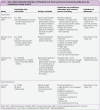Predictors of cervical cancer screening adherence in the United States: a systematic review
- PMID: 25032031
- PMCID: PMC4093462
Predictors of cervical cancer screening adherence in the United States: a systematic review
Abstract
Cervical cancer incidence rates have decreased dramatically since the implementation of the Papanicolaou (Pap) smear. Nevertheless, the American Cancer Society (ACS) estimates for 2013 predicted more than 12,000 new cases of cervical cancer in the United States. Given that some subpopulations in the United States are at a higher risk for cervical cancer than others, efforts to increase screening adherence are warranted. Many studies have explored the demographics of underscreened women, but no systematic reviews of screening demographics in adult US women were identified in the past 10 years, after release of the 2002 ACS cervical cancer screening guidelines. Knowledge of adherence to these guidelines becomes important as new guidelines were developed and released in 2012. The purpose of this systematic review of relevant studies was to identify factors that predict the use of cervical cancer screening in US women. Variables found to be significantly associated with adherence to screening included education, financial status, acculturation, psychosocial issues, and marital status. Using this information, nurse practitioners and other providers can target specific at-risk populations to increase screening by educating women about the need for cervical cancer screening and ensuring access to methods for prevention and early detection of the disease.
Figures





References
-
- Cervical cancer overview. American Cancer Society. 2013 Retrieved from http://www.cancer.org/Cancer/CervicalCancer/OverviewGuide/cervical-cance....
-
- American Cancer Society guidelines for the early detection of cancer. American Cancer Society. 2012a Retrieved from http://www.cancer.org/Healthy/FindCancerEarly/CancerScreeningGuidelines/....
-
- Cervical cancer: Prevention and early detection. American Cancer Society. 2012b Retrieved from http://www.cancer.org/cancer/cervicalcancer/moreinformation/cervicalcanc....
-
- American Congress of Obstetricians and Gynecologists. Cervical cancer screening. 2013 Retrieved from https://www.acog.org/~/media/For%20Patients/faq085.pdf?dmc=1&ts=20131223....
-
- Bazargan Mohsen, Bazargan Shahrzad H, Farooq Muhammad, Baker Richard S. Correlates of cervical cancer screening among underserved Hispanic and African-American women. Preventive medicine. 2004;39:465–473. - PubMed
Publication types
LinkOut - more resources
Full Text Sources
Research Materials
Miscellaneous
